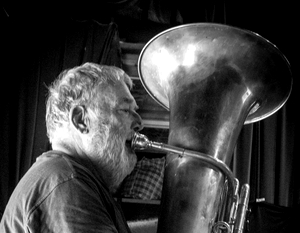Hitting that practice room wall ......” Pablo Casals
In the six years since returning to ever more active performance I repeatedly encounter an awkward time of year. A period between mid December and mid February where the music performance stops. It is summer time, holiday time in the Southern Hemisphere. In Australia we celebrate Christmas, Boxing day, New year and our national holiday. We take holidays (sic. Vacations) and take “recreation time” away; party and hang out. It is not strictly speaking a time of classical music concerts and generally is a well deserved break away from the usually busy music making time of multiple rehearsals and performances held in the last quarter of every year. It is a natural, season rhythmal that I anticipated this year, in both expecting it and intuitively planning for an annual musical void.
I would need to feed my tuba playing junkie. That guy in here who feels a physical desire to blow the horn, and be making big sounds; playing.
In a tried, true and trusted fashion, for me, this means concentrating on basics. It is an instinct which immediately kicked-in when I took up the horn again after twenty-four years. It works well. I was trained well over a long time by a posse of fine tuba teachers. So “Holiday” time is basic practice time, a return to tuba roots and an opportunity to look over previous solo music and excerpts. A chance to raise the bar and set some new goals to hone those standards of tone and articulation, respiration and musical execution.
This year it consists of a regular working - playing through the Special Studies for the Tuba by Arnold Jacobs (compiled by Charles Schuchat):
Published on the Internet: HERE
Also published as: Rusch & Jacobs Hal Leonard Advanced Band Method - Tuba
These are excellent exercises with commentary by Mr Jacobs, presented in his concise and authentic fashion. Reading his commentaries, for me. is akin to having him sit beside me once again; I can hear his voice, with its bass-baritone tone and inflection. Playing these exercises slowly, in all keys and octaves is simple and effective; teaches patience and develops breathing, tone and resonance. “Meat & Potatoes’” practice in producing solid sound, tone production and technique in service to our musical imagination.
Another of basic material crossing my music stand is of course “Blazhevich 70 Studies for BBb Tuba”. I play nos. 1 -4 as a musical suite and have given titles to several favourites (eg # 17 “Symphonic Nightmare” or # 18 “ At king Kong’s BBQ”).
These are tuba etudes that have style and form to dig into with opportunities to vary style and tempo. This year I have been working through # 69, an octave harmonic study in D# minor, which is a mental bender and finger twister that is also very satisfying, as one gets it into line and can roll with the progressions. Highly recommended.
Other fun material that shows improvement has been a “Holst Low Range Exercise”
So many wonderful exercises complied here, in a valuable on-line resource by an excellent player and teacher George Palton
The Holst exercise, for example, takes one through all keys employing the famous bass line from the 1st Suite in Eb for Military Band in covering the contra bass range and discipling fingers. I believe going to musical extremes in practice can help set us up for other musical challenges that can come along in our ensemble performance. In this case the Holst Low Range Exercise” becomes part of my preparation for performing Holst Hammersmith in a concert production later this year.
I also confess to studying and practicing (for fun) of one of Zappa’s famous test pieces: “Rollo Interior Interlude” (from St Alphanso’s Pancake Breakfast )which is ahair raising set of progressions and not for the timid (as well as being in treble clef in this transcription) *(I need to transcribe this into bass clef). Zappa’s other test piece is “The Black Page” which I haven’t reached for yet ...
I have also played through orchestral and band excerpts and went back to the Hindemith Tuba Sonata and John Stevens tuba concerto Journey. A chance to visit these ‘old friends ‘ and renew my musical association after much time away. Insights into different points of view on the music and its expression come into focus. Resulting in a sudden (irrational) desire to organize a tuba recital comes up strongly, and I start to think of associates to contact, and what venues could possibly work ... Then stop! I have hit the practice room fantasy wall. Time to remind myself to get a grip, and return to the DMA project at hand; which is barely under control at any time. Get back to work; now.
Because, as good and useful and developmental and satisfying to my need, the urge, to play the wind bass tuba, my personal practice can only can take me so far.
There is a wall(s) to the practice room. It’s lonely in here. Mostly. Except for that music critic, who sits in the corner of my mind and needs his own disciplining (more on “HIM” another time).
The musical performance circle remains incomplete. That rehearsal, practice, rehearsal (repeat) cycle leading to the performance.
The ensemble gestalt thing that comes alive with our orchestral associations that we enjoy, and contribute within by creating, making accomplished musical performances.
Realizing music.
Time to be back on the road again and get the band back together.
2020 looks to be the biggest year musically for me yet. I am as ready as ever to embrace the opportunities and challenges to produce those bass sounds and progressions for a greater Gestalt That one comprised of Composer/ Music, Ensemble, Audience.
Let the music begin ... “Release the beast!”


Comments